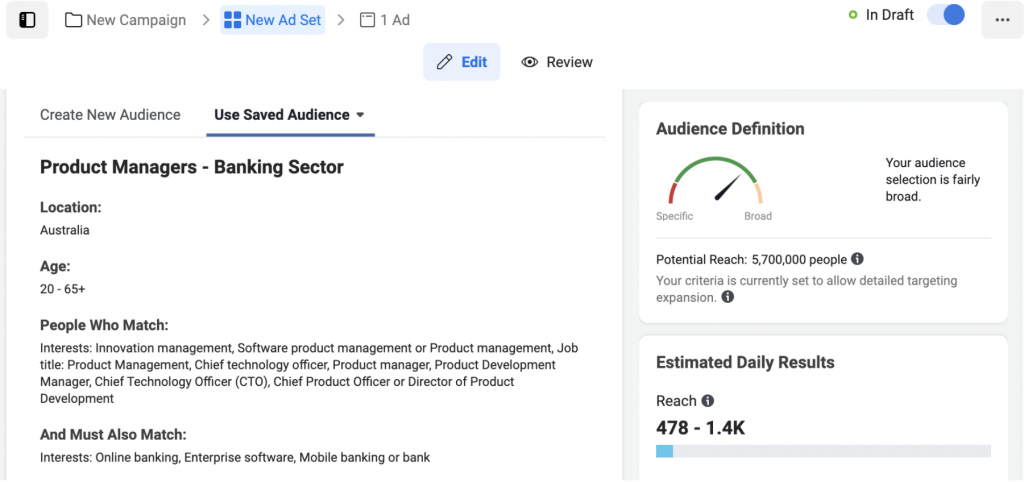
JTBD is a great tool for understanding what you can do for your customer and helping you develop a product (or feature set) around that. The challenge with JTBD when you start working on your Go-to-Market is that it can be harder to do target marketing than traditional approaches, but this challenge is where the opportunity lies.
Let’s say you’re developing a tool for people in a team to chat with each other about work (think Slack or Microsoft Teams).
With a persona-based approach, you might describe your customers as “knowledge workers, likely aged 22-45.” You can quite easily visualise this group and target them. Most channels to market allow for this type of targeting, from ads to outbound call campaigns. Media like magazines, websites and email newsletters will share with you the demographics of their audience (“our readers are 30-40-year-old professional women”). Purchasing a call list, you’ll be asked demographic information like where are the companies based that you are targeting and what is the decision maker’s role title.
With a Jobs-to-be-Done approach, you would say, for example, that your customer is someone that needs “help to communicate instantly and easily with my colleagues so that I can work more efficiently and effectively”. It’s harder to translate this into the form advertisers, and sales teams are used to dealing with. You can’t as easily buy an outbound call list of people that need help communicating instantly, particularly if your product is new. You also can’t as easily buy ads or media to hit the people with this need.
If you take the path of least resistance then your Go-to-Market teams and activities will end up using a persona because that’s how the channels are geared. While your product team works in Jobs-to-be-Done.
If you’re lucky – maybe you have a product of broad appeal – the common Go-to-Market channels will give you the ability to target your activities at interests that are close enough to what you need to take to market. Facebook, for example, lets you run ads targeted at people with interests (like the groups they are involved in, or have listed).

However, if you’re like most products and services or you really want to get more efficient and effective with your Go-to-Market, then you’re going to have to put more work in. It will be worth it.
Why Go-to-Market Through Jobs-to-be-Done
Thinking about your Go-to-Market through the lens of JTBD will help you:
- Uncover more effective and efficient ways of targeting your customers. If you can hit them right when and where they need the job done, for example, then you’re in a prime position.
- Make your product onboarding better. You will have a more seamless onboarding experience because you will likely find ways to bring your Go-to-Market and your product together.
- Make your new customers stickier. Your new customers will be a better fit, they’ll likely stay longer and they’ll likely appreciate the experience they had coming on board.
- Filter out the noise. Demographic and persona targeting often leads to a lot of people that fit the profile, but don’t have the pain or need the job your product solves done.
The side effect of going to market with Jobs-to-be-Done is that you end up having quite a bit of fun creatively across product, marketing and sales teams.
How to Go-to-Market with Jobs-to-be-Done
The essential part of going to market with JTBD is researching to identify channels that will enable you to meet your customer when and where they are experiencing or thinking about the job your product can do for them. You will want to run customer interviews and survey people on their JTBD in order to understand where and when to meet them.
Then you will need to put some research in to find out which of the channels, places and times that your customers are at that will allow you to target your customers in the way that works for your product. The book Traction provides a comprehensive list of channels you can work through and how each channel works.
Then experiment with the channels, for example by running landing page experiments or Mechanical Turk prototypes. You may even consider reworking your product or the onboarding flow in order to meet people where they are. In some cases, I’ve seen it necessary to completely redesign the product – e.g. to be a plugin – rather than a standalone web application.
Finally, the more integrated your product and Go-to-Market are, the better. They can’t be seen as two separate silos, and they need to be one connected experience and offering.

Scott Middleton
CEO & Founder
Scott has been involved in the launch and growth of 61+ products and has published over 120 articles and videos that have been viewed over 120,000 times. Terem’s product development and strategy arm, builds and takes clients tech products to market, while the joint venture arm focuses on building tech spinouts in partnership with market leaders.
Twitter: @scottmiddleton
LinkedIn: linkedin.com/in/scottmiddleton